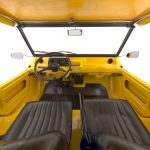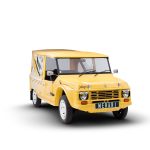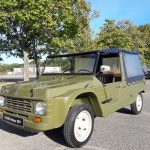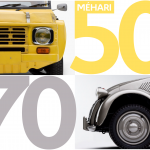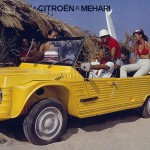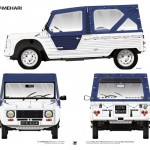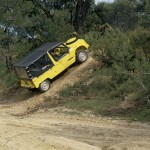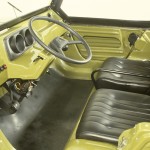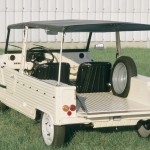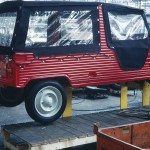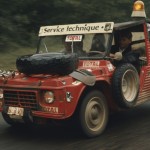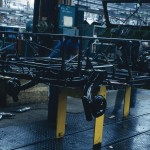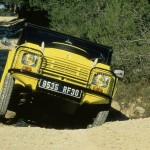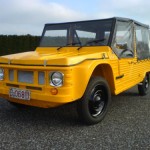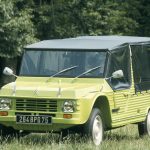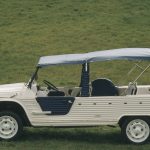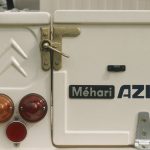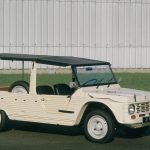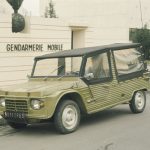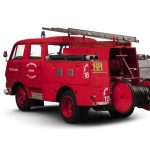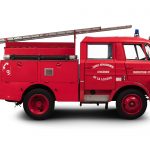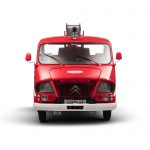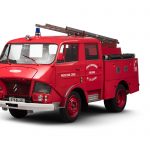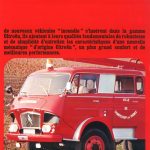
(english text below)
Unten die Pressemitteilung von Citroën aus Frankreich, übersetzt ins Deutsche durch die Amicale. Es sei noch darauf hingewiesen, daß ein detailliertes Feature zu Roland de la Poype, dem Schöpfer des Méhari, vor einigen Jahren auf den Amicale-Seiten veröffentlicht wurde.
CITROËN MEHARI: 55 JAHRE UND IMMER NOCH INSPIRIEREND
* Citroën feiert den 55. Geburtstag des Mehari, der am 16. Mai 1968 auf dem Golfplatz von Deauville vorgestellt wurde.
* Zwischen 1968 und 1987 wurden 144.953 Exemplare produziert, hauptsächlich in den Citroën-Werken in Forest, Belgien.
* Dieses untypische, gelände- und allwettertaugliche Fahrzeug verführte eine ganze Generation durch seine Modularität, seine Zweckmäßigkeit und seinen wirtschaftlichen Vorteilen.
* Der Mehari wurde zu einer Ikone von Citroën und der gesamten Automobilwelt, aber auch in verschiedenen aber auch in verschiedenen Bereichen wie der französischen Armee und dem Kino.
* Diese unverwechselbare und freizeitorientierte Einstellung teilt der Mehari mit dem Citroën C3 Pluriel, der demnächst sein20-jähriges Jubiläum feiert, und seit kurzem auch mit dem My Ami Buggy, der demnächst in seiner neuesten Ausgabe auf den
Auflage auf den Markt kommt.
Poissy, 16. Mai 2023
Es war am 16. Mai 1968, vor 55 Jahren, im Herzen der französischen Studentenprotestbewegung, als Citroën auf dem Golfplatz von Deauville sein neues Fahrzeug vorstellte: den Mehari. Ein atypischer Pick-up mit einer Leistung von 28 bis 32 PS, mit einer ABS-Karosserie (Acrylnitril-Butadien-Styrol), entworfen von Roland de La Poype. Gebaut auf einer Dyane 6-Plattform aufgebaut, wurde er bei seiner Veröffentlichung als Dyane 6 Mehari vorgestellt. Er wurde fast 20 Jahre lang zwischen 1968 und 1987 produziert, wurden 144.953 Exemplare gebaut (darunter 1.213 4×4 Mehari), was einen überraschenden Erfolg für dieses ungewöhnliche Fahrzeug darstellte. Der Mehari wurde größtenteils im Citroën-Werk in Forest, Belgien, hergestellt, aber auch in sieben weiteren Fabriken in Frankreich, Spanien und Portugal.
EIN GELÄNDEGÄNGIGES UND GANZJÄHRIG EINSETZBARES FAHRZEUG
Der Name des Mehari leitet sich von der männlichen Bezeichnung “méhari” ab, die den Dromedaren in Nordafrika und in der Sahara gegeben wird. Diese Tiere sind bekannt für ihre Geländetauglichkeit, ihre Widerstandsfähigkeit und ihre Nüchternheit. Das mehari ist in der Lage, sowohl Güter als auch Personen über weite Strecken zu transportieren. Dieser Name ist daher sehr für das Modell Citroën Mehari passend, das für seine Anpassungsfähigkeit an jedes Gelände bekannt ist. Es ist ein Fahrzeug mit vielen Kapazitäten.
Von außen scheint der Mehari nicht wirklich für alle Jahreszeiten geeignet zu sein, denn er sieht eher wie ein kleines Cabrio, das eigentlich nur im Sommerurlaub benutzt wird. Dank einer Winterabdeckung ist das Auto vollständig abgedichtet, was es zu einem Auto macht, das das ganze Jahr über genutzt werden kann.
PRAKTISCH, MODULAR UND WIRTSCHAFTLICH
Der Mehari ist hochgradig modular, da ein Teil des Bodens in eine Rückenlehne umgewandelt werden kann, die es ermöglicht, zwei Sitze im hinteren Bereich und damit bis zu 4 Passagiere zu transportieren. Er kann in einer Vielzahl von Situationen eingesetzt werden.
Die Karosserie besteht aus nur 11 leicht zu reparierenden Teilen und kann mit einem einzigen Wasserstrahl von innen und außen gereinigt werden. Das macht das Auto wartungsfreundlich und wirtschaftlich für seine Kunden. Dieses atypische, modulare und wirtschaftliche Konzept, das mit für die damalige Zeit modernen Materialien und einem innovativen Design entworfen wurde, ist eine echte Kindheitserinnerung für eine ganze Generation und im Laufe der Jahre zu einer echten Automobilikone geworden.
DREI MYTHISCHE VERSIONEN
Obwohl er fast 20 Jahre lang produziert wurde, gab es vom Mehari nur drei verschiedene Versionen, darunter zwei limitierte Editionen. Im Jahr 1983 wurden zwei Sondereditionen aufgelegt. Zum einen der Méhari plage, der mit seinem Urlaubslook und seiner auffälligen gelben Farbe, der in Spanien und Portugal verkauft wurde. Und im April 1983 wurde der Méhari Azur auf dem französischen, italienischen und portugiesischen Markt in nur 700 Exemplaren eingeführt. 1979 führte Citroën mit der 4×4-Version eine neue Variante ein, die bis heute eine kaum zu übertreffende Freiheit bietet.
EINE BESONDERS VIELFÄLTIGE KARRIERE
Der Mehari ist ein Fahrzeug von besonderem Interesse für öffentliche Verwaltungen wie Polizei, Zoll, Flughäfen, Rennbahnen und viele andere, aber auch für Geschäftsleute, Handwerker und Privatpersonen.
Er hatte die Gelegenheit, eine lange Karriere bei der französischen Armee zu machen, die zwischen 1972 und 1987 insgesamt 11.457 Mehari 1972 und 1987 bestellte.
Der Mehari 4×4 hat eine Karriere in der medizinischen Versorgung auf den Straßen der Welt gemacht. Er nahm an der Rallye Paris-Dakar im Jahr 1980 teil, bei der zehn Mehari 4×4 gechartert wurden, um entlang der Strecke medizinische Hilfe zu leisten. Schließlich hat der Mehari eine große Filmkarriere, insbesondere dank des berühmten Films Le gendarme de Saint Tropez mit Louis de Funès.
Kontakt:
BENJAMIN DEMOZAY
LEITER DER PRODUKTKOMMUNIKATION
Conservatoire Citroën
Boulevard André Citroën
93600 Aulnay – sous – Bois
- mehari
- mehari
- mehari
- mehari
- mehari
- mehari
- mehari
- mehari
- mehari
- Une Citroën Méhari 4×4 sur une piste tout-terrain en 1979. Photo de Robert Lamanda, Eric Vivier et Georges Guyot. Utilisation éditoriale uniquement, nous contacter pour toute autre utilisation
- Une Citroën Méhari Azur dans un pré en 1983. Photo de Georges Guyot. Utilisation éditoriale uniquement, nous contacter pour toute autre utilisation
- Une Citroën Méhari dans un pré en 1978. Photo de Georges Guyot. Utilisation éditoriale uniquement, nous contacter pour toute autre utilisation
- Une Citroën Méhari décapotable rouge sur une plage tractant un bateau pneumatique à moteur, un homme se tient à côté et un petit garçon à l’arrière en 1971. Utilisation éditoriale uniquement, nous contacter pour toute autre utilisation
- Une Citroën Méhari Azur dans un pré en 1983. Photo de Georges Guyot. Utilisation éditoriale uniquement, nous contacter pour toute autre utilisation
- Vue de détail de l’arrière de la Citroën Méhari Azur en 1983. Photo de Georges Guyot. Utilisation éditoriale uniquement, nous contacter pour toute autre utilisation
- Une Citroën Méhari Entreprise sur un parking en 1978. Photo de Georges Guyot. Utilisation éditoriale uniquement, nous contacter pour toute autre utilisation
- Une Citroën Méhari de la gendarmerie nationale stationnée devant les locaux de la gendarmerie mobile en 1974. Photo de Jean-François Malard. Utilisation éditoriale uniquement, nous contacter pour toute autre utilisation
—–
Below please find the press release from today about the 55 years of the Méhari. It should also be noted that a detailed feature on Roland de la Poype, creator of the Méhari, was published on the Amicale pages a few years ago… 🙂
PRESS RELEASE
CITROËN MEHARI: 55 YEARS AND STILL INSPIRING
Citroën is celebrating the 55th anniversary of the Mehari, revealed on 16 May 1968 at the Deauville golf course.
Between 1968 and 1987, 144,953 units were produced, mainly at the Citroën factory in Forest, Belgium.
This atypical, all-terrain and all-season vehicle seduced a whole generation with its modularity, its practicality and its economic benefits.
The Mehari became an iconic model of Citroën and more globally of the automotive world, but also in various environments such as the French army and the cinema.
The Mehari shares this distinctive and leisure-oriented attitude with the Citroën C3 Pluriel, which will soon celebrate its 20th anniversary, and more recently with My Ami Buggy, which will be soon marketed in its latest edition.
Poissy, 16th May 2023
It was on 16 May 1968, 55 years ago, at the heart of the French student protest movement, that Citroën revealed its new vehicle at the Deauville golf course: the Mehari. An atypical pick-up offering from 28 to 32 hp, with an ABS (acrylonitrile butadiene styrene) plastic body, designed by Roland de La Poype. Built on a Dyane 6 platform, it was presented with the name of Dyane 6 Mehari on his release. Produced for almost 20 years between 1968 and 1987, 144,953 units were built (including 1,213 4×4 Mehari), making a surprising success for this unusual vehicle. The Mehari was produced, for the most part of it, in the Citroën factory in Forest, Belgium, but also in seven other factories in France, Spain and Portugal.
AN ALL-TERRAIN AND ALL-SEASON VEHICULE
The name of the Mehari comes from the masculine name mehari which is the name given to dromedaries in North Africa and in the Sahara. These animals are known for their off-road ability, their resistance and their sobriety. The mehari is able to transport both goods and passengers over long distances. This name is therefore very representative of the Citroën Mehari model, known for its adaptation to all terrains. It’s a vehicle with many
capacities.
From the outside, the Mehari doesn’t really seem to be suitable for all seasons, as it looks more like a small convertible used during the summer holidays. Thanks to a winter cover, the car is completely sealed, which makes it a car that can be used all year round.
PRATICAL, MODULAR AND ECONOMICAL
The Mehari is highly modular, being able to transform part of its floor into a backrest, which allows it to add two seats at the rear and thus accommodate up to 4 passengers. It can be used in a wide range of situations, carrying both different loads and a reasonable number of passengers.
The car body is made up of only 11 easily repairable parts and can be cleaned with a single blast of water both inside and outside. This makes the car easy to maintain and economical for its customers.
A true childhood memory for a whole generation, this atypical, modular and economical concept designed with modern materials for the time and an innovative bodywork has become a true automotive icon over the years.
THREE MYTHICAL VERSIONS
Although it was produced for almost 20 years, the Mehari only had three different versions, including two limited editions. In 1983, two special editions were launched. Firstly the Méhari plage, with its holiday look and flashy yellow colour, which was sold in Spain and in Portugal. And, in April 1983, the Méhari Azur was launched on the French, the Italian and the Portuguese markets in just 700 units. In 1979, Citroën introduced a new variant with the 4×4 version, which offered a freedom that is almost unequalled even today.
A PARTICULARLY DIVERSE CAREER
The Mehari is a vehicle of particular interest to public administrations such as the police, customs, airports, racecourses and many others, but also to shopkeepers, craftsmen and private individuals.
It had the opportunity to have a long career with the French army, which ordered a total of 11,457 Mehari between 1972 and 1987.
The Mehari 4×4 has a career in medical assistance on the roads of the world. It took part in the Paris-Dakar Rally in 1980, in which ten 4×4 Mehari were chartered to provide medical assistance along the route. Finally, the Mehari had a great cinematographic career, especially thanks to the famous film Le gendarme de Saint Tropez with Louis de Funès.
Contact:
BENJAMIN DEMOZAY
PRODUCT COMMUNICATION MANAGER
BENJAMIN.DEMOZAY@CITROEN.COM
Conservatoire Citroën
Boulevard André Citroën
93600 Aulnay – sous – Bois

